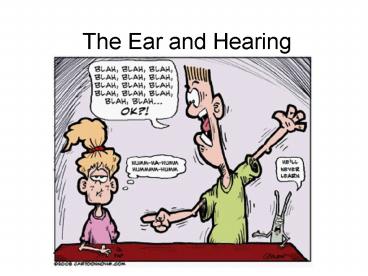The Ear and Hearing - PowerPoint PPT Presentation
1 / 16
Title:
The Ear and Hearing
Description:
Sensory receptors in the ear are called mechanoreceptors. ... The outer and middle ear are only used for hearing. ... How does equilibrium work? ... – PowerPoint PPT presentation
Number of Views:532
Avg rating:3.0/5.0
Title: The Ear and Hearing
1
The Ear and Hearing
2
What are the functions of the ear?
- Hearing
- Balance
3
Sensory receptors
- Sensory receptors in the ear are called
mechanoreceptors. - Mechanoreceptors respond to physical forces.
- Hearing receptors are stimulated by sound
vibrations moving through fluid. - Balance receptors are stimulated by fluid
movement in the balance organs.
4
Anatomy of the Ear
- Three major areas outer (external), middle, and
inner (internal) - The outer and middle ear are only used for
hearing. - The inner ear is used for both hearing and
balance.
5
(No Transcript)
6
The Outer (External) Ear
- The pinna is the shell-shaped part of the ear
that we usually see. - The external auditory canal is a short chamber in
the temporal bone of the skull. This canal ends
at the tympanic membrane. - The tympanic membrane (eardrum) separates the
outer ear from the inner ear.
7
Middle Ear (Tympanic cavity)
- An air filled cavity in the temporal bone.
- Runs from the eardrum to a bony wall.
- The bony wall has two openings called the oval
window and the round window. - The auditory (Eustachian) tube connects the
middle ear to the throat. It allows for pressure
to be equal on both sides of the eardrum. If the
pressures are not equal, hearing is difficult and
the ear may hurt.
8
Middle Ear cont.
- Three bones in the middle ear.
- Malleus (hammer)
- Incus (anvil)
- Stapes (stirrup)
- When the eardrum moves, the movement is
transferred to the malleus. The malleus moves
the incus, the incus moves the stapes. The
stapes presses on the oval window.
9
Inner (Internal) Ear
- Made of chambers called the bony labyrinth.
- Filled with a fluid called perilymph.
- Three subdivisions cochlea, vestibule,
semicircular canals.
10
How do we hear?
- Sound waves strike the eardrum.
- The eardrum transfers movement through the
ossicles. - The stapes transfers the movement to the oval
window. The movement of the ossicles amplifies
the signal. - The movement of the oval window is transferred
through the fluid of the inner ear.
11
How do we hear? cont.
- As the fluid in the cochlea moves, it pushes and
pulls on hair cells. This movement of hairs is
translated into a nerve impulse.
12
(No Transcript)
13
How does equilibrium work?
- Some receptors in the inner ear are responsible
for static equilibrium, and some are responsible
for dynamic equilibrium. - Static equilibrium tells our brain which way is
up and down. - Receptors in the vestibule respond to how the
head is oriented in relation to gravity.
Information is received by hair cells and
converted into a nerve impulse.
14
(No Transcript)
15
How does equilibrium work? cont.
- Dynamic equilibrium tells our brain if our head
is rotating or at an angle. - Receptors in the semicircular canals are
orientated in the three planes of space. - Movement of the head causes movement of the
endolymph. This movement is received by hair
cells and converted into a nerve impulse.
16
(No Transcript)































